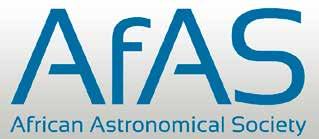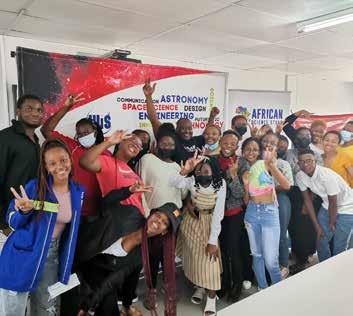
8 minute read
SUTHERLAND TO PALAPYE
KEVIN GOVENDER
Ex-officio (Advisor)
Advertisement
Govender began work at the International Astronomical Union (IAU) Office of Astronomy for Development (OAD) in 2011 as its first Director, and has since led the establishment of eleven regional offices around the world. During his previous position as the Manager of the Southern African Large Telescope’s Collateral Benefits Programme at the South African Astronomical Observatory he worked extensively, especially within the African continent, in the area of “astronomy for development”, including a focused effort to stimulate the local economy of Sutherland through astro-tourism. In 2007 he was part of a small IAU delegation that successfully lobbied the United Nations to declare 2009 the International Year of Astronomy (IYA2009). He chaired the “Developing Astronomy Globally” Cornerstone Project of IYA2009 and was involved in the development of the 2010-2020 IAU Strategic Plan, a visionary document mapping out a decadal strategy to use astronomy to stimulate global development, and contributed to the subsequent 2020-2030 strategic plan.
He has served the South African education and outreach
community in various roles such as Chair of Scifest Africa’s Advisory Committee, board member of the Southern African Association of Science and Technology Centres, member of the Quest Editorial Board and STEM Committee of the Academy of Science of South Africa. Internationally he has served on the IAU’s Executive Committee Working Group on IYA2009, member of the EPO Advisory Council of Associated Universities Inc, the OECD Expert Group on the Socio-Economic Impact of Research Infrastructures, and member of the Board of Astronomers Without Borders. He was a key facilitator in the establishment of the African Astronomical Society and remains an advisor to their Executive Committee. Coming from an experimental nuclear physics background and with experience from many community development initiatives in post-apartheid South Africa, Kevin was previously named one of the Mail & Guardian’s Top 200 Young South Africans, and received the National Science and Technology Forum’s Science Communicator award in 2011. In March 2016
Kevin was jointly awarded the Edinburgh Medal, together with the IAU.
YUNUS MANJOO
Ex-officio (Advisor)
Manjoo is a retired Business Director who worked for the National Research Foundation (NRF) for almost 20 years. Prior to joining the NRF, he worked at Unilever South Africa in Durban for 22 years in various Accounting/IT and Business positions. His expertise is in Management Accounting and Business Management and he has worked with the National Research Facilities of the NRF including SAAO, SARAO and iThemba LABS.
He is a science graduate with a BSc Honours in Computer Science having studied Mathematics in his final year of undergraduate studies and Physics and Chemistry as well. He is currently contracted to AfAS as a Business Consultant providing strategic business advice to the Executive Committee and managing the Accounting and Payroll systems.
Yunus has been involved in South African astronomy for at least the past 10 years and also provides business support to the BRICS Astronomy Working Group and the National Astrophysics and Space Science Programme (NASSP) for Honours and Masters students at 3 universities in South Africa (UCT/NWU/UKZN). He brings much-needed business expertise and strategic as well as operations skills to AfAS and the other organisations that he is currently involved with.


FROM SUTHERLAND TO PALAPYE
ONE NIGHT IN SILENCE WITH 1000 STARS
By: Unathi Kondile
Sutherland, in the Northern Cape province of South Africa is about 350km away from Cape Town. It’s a four-hour drive. As you enter, a sign welcomes you in English and Afrikaans. This is one of those one-way towns that you can literally walk through in less than 15 minutes. There are a few dome-shaped buildings along the main road and posters bearing telescopes and stargazing opportunities.
A few kilometres outside the town lies the Southern
Hemisphere's largest optical telescope, the South African Large Telescope (SALT) that is 1800m above sea-level.
There are many more telescopes for various companies, agencies and countries atop of this hill. We are to spend one night at the South African Astronomical Observatory (SAAO) cottages at the observatory’s yard. Dead-silence does not even begin to describe how it sounds to be there at night. If not to see the stars and SALT one can also just do this trip for peace of mind. You will wake up feeling refreshed.
Earlier on in the day we toured the observatory’s gallery space. There are even virtual photo opportunities to take a picture in space. We marvel at the 3D miniature model of SALT, get an introduction to what stars are and as the sun sets, we get to actually go view the stars through telescopes. Beautiful.
The next day we are up early to go tour SALT. None of our Facebook friends believe us when we say these large telescope structures are actually right here in South Africa. They think it is all photoshopped. When one thinks of a telescope, they rarely ever think of them being this large. Timothy Fransman, a SALT technician, welcomes us gladly as he sits pressing a myriad of buttons. Timothy studied mechanical engineering at the Cape Peninsula University of Technology (CPUT) and then got an in-service opportunity to be part of SALT and later became a permanent staff member.
“I am part of the day-team working closely with the engineering, electronics and mechanical groups. With the help of software, we are able to identify and solve telescope complications. We also inspect, repair, clean and maintain industrial machinery and equipment. We make things easy for scientists to work with during the evenings,” says Fransman before we climb a flight of stairs that leads us into a giant room with a 11.1 by 9.8 metres mirror. The mirror is made up of 91 identical hexagonal segments. Light beams in through one of the rooftop openings and we then witnessed the telescope change its position, thanks to Fransman, who sits at the controls.
It is indeed Africa’s giant eye on the sky.
The next day we are off to host our African Science Stars Journalism workshop in town. Close to 20 young people join us for this and a huge chunk of this workshop is done in Afrikaans. Most of the young people here are aware of the Sutherland Observatory and some have even worked there. They are quite excited to send us their own stories for publication in this magazine and we, too, cannot wait to start publishing their stories. Watch this space!
VISIT SUTHERLAND
Make sure you book yourself a tour of the Sutherland Observatory by calling +27 23 571 2436 or emailing: suthbookings@saao.ac.za
The Sutherland Observatory address is: Old Fraserburg Road Sutherland
South Africa
“IT’S PALAPE BUT SPELT PALAPYE!”
Next on our travel list was Palapye in Botswana. We’d always wanted to visit and experience the Botswana International University of Science and Technology (BIUST) that everyone spoke about when we visited Gaborone for our last edition. We set off from Johannesburg and it takes us roughly four hours to get to Gaborone. From there we drive an additional three hours to get to Palapye. By then we are too tired to do any touristy things so we go straight to bed at one of the bed-andbreakfasts near town.
BIUST is a research-intensive university that specialises in Science, Technology, Engineering & Mathematics (STEM) at both undergraduate and post-graduate level. It is a relatively young university which started accepting students a decade ago. It is situated on a 2500 hectare plot.
BUIST is located on Plot 10071 in Palapye, Botswana. Visit their website at biust.ac.bw
Upon entering the yard we still have to drive a kilometre or two to get sight of the campus buildings. We are greeted by students dressed in lab-coats, all purposely rushing to the next class as we ask around for the Astronomy section. Eventually we are led into a prefab classroom filled with a group of students led by the Founder and Director of Women in STEM-BW, Tumo Kedumele.
Dr Haniso Motlhabane, who is currently the director of preuniversity Academic Programmes at BIUST also welcomes us with a keynote address that unpacks the history of BIUST as well as plans for the future.
Dr Motlhabane was part of the university’s founding task team. He speaks passionately about the planning phases of the university and the support the university got from its current chancellor, His Excellency Festus Mogae.
The university has two faculties, the Faculty of Engineering & Technology and the Faculty of Sciences. There is also a Centre for Business Management, Entrepreneurship and General Education. In total there they have around 2 000 students. As the university grows this number is expected to go up to 6 000 students. “The aim of this university is to increase the pool of STEM graduates to address the shortage of skilled scientists and technologists in our country; we strive for global competitiveness and all of this excellence will come from right here,” says Dr Motlhabane.
We then proceed with our African Science Stars workshop and get to engage meaningfully with the group of students. In this group we had engineering students, Physics and Astronomy, Statistics, Geology and Computer Science students. They were all interested in writing about their academic journeys and individual research interests.
One thing we got from this group of students is that they really wanted to write stories that solve immediate community problems. Although not all focused on astronomy and space science it was evident that BIUST teaches them to be problem solvers. Ideas on converting green algae into fuel were shared to solve the fuel and energy challenges that face Botswana. Now the next step is to see the students submit their story ideas to this publication and we publish.
We were just in awe of their enthusiasm and look forward to visiting BIUST again.











